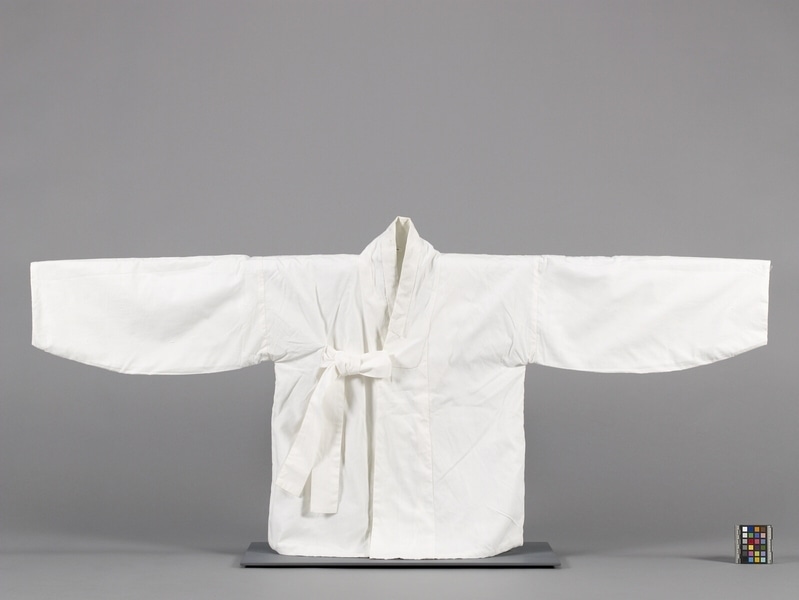Jacket Item Number: 2535/3 from the MOA: University of British Columbia


Description
Man’s jacket of fine white cotton fabric lined with white cotton gauze. Jacket is waist-length and flares slightly from the top. The centre front opening has inset panels on both sides that overlap when the garment is worn. The V neckline is edged on the outside and inside with facings. The facing has a rounded lower corner on the left side and a square corner on the right with a pointed edge project beyond the inside edge of the jacket. Centred on the end of the left facing is a long, wide ribbon tie made of the same fabric, with a corresponding tie sewn to the mid-point of the jacket on the right. The V neck is finished with a white narrow white cotton collar or facing. There is a centre back seam. The long sleeves are set in with a straight seam and a convex curve on the lower edge, narrowing to the wrist. The inner lining is white cotton. Jacket made to be worn with pants and coat (2535/1-2).
History Of Use
Clothing of good quality white cotton was worn by rural intellectuals, such as teachers, in the 1950s. Good quality cotton and rayon were very precious in the early 1950s in the countryside. In the immediate postwar period ordinary rural people wore clothing made of blanket fabric, or clothing left from the army or obtained from UNICEF. Later those who remained poor wore odd jackets and pants obtained through relief programmes, while those who were more prosperous wore white clothing except for festivals, when coloured clothing was worn. Older men wore long coats “Doo-ru-ma-gui” and horsehair hats. In the winter people wore padded clothing. When rural women worked in the rice paddies, they pulled their skirts up between their legs so they became like pants. Rural people wore very clean clothes on social occasions. Women washed the clothing in cold mountain streams, and ironed it by beating it against a stone platform with wooden beaters, two women sitting facing each other. “Jo-go-ri” for men were longer than those for women, and the lower edge of their sleeves was less rounded. Inside ties were less frequently used at this time than they had been previously. In the 1950s the ribbon ties were less carefully attached than they had been earlier. In the cities, men began wearing western suits during this period, and urban women wore Korean jackets, “Jo-go-ri”, and skirts, “Chi’ma”, in finer materials and bright colours, although by 1958 they, too, began to wear western clothing.
Narrative
Mr. Waddell did not actually wear this set of clothing. He also had padded socks and rubber Korean-style shoes to complete the outfit.
Specific Techniques
All seams appear to be hand-sewn. All are concealed between the two layers of the jacket. The jacket was sewn inside-out and then reversed through a small opening, which was then sewn shut.
Item History
- Made in Korea between 1955 and 1958
- Collected between 1955 and 1958
- Owned by Joan Waddell before August 18, 2001
- Received from Joan Waddell (Donor) on August 18, 2001
What
Who
- Culture
- Korean
- Previous Owner
- Joan Waddell
- Received from
- Joan Waddell (Donor)
Where
- Holding Institution
- MOA: University of British Columbia
- Made in
- Korea
When
- Creation Date
- between 1955 and 1958
- Collection Date
- between 1955 and 1958
- Ownership Date
- before August 18, 2001
- Acquisition Date
- on August 18, 2001
Other
- Item Classes
- textiles
- Condition
- good
- Accession Number
- 2535/0003